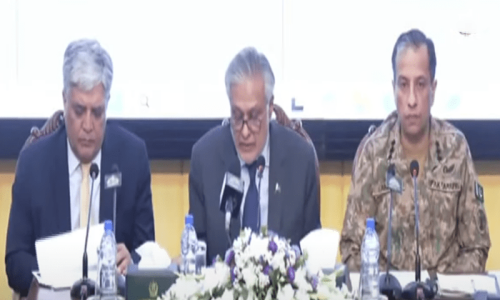MOHMAND: Work on Mohmand Dam, the country’s largest hydropower project since the construction of Tarbela dam in 1960s, is in full swing despite hiccups caused by coronavirus pandemic.
The dam is being built on the River Swat in Mohmand district of Khyber Pakhtunkhwa, around five kilometers upstream of Munda headwork at the cost of over Rs300 billion, with the capacity to produce 800 megawatts of electricity.
On Saturday, chairman of the Water and Power Development Authority (Wapda) retired Lt Gen Muzammil Hussain briefed journalists about progress on the project.
Construction workers were seen remove earth and dig tunnels in the foothills of craggy slopes, which surround the narrow river course and debouch into plains of Charsadda district.
Wapda says project inaugurated in 2019 to be completed in 2025
The Wapda chairman said work on the two diversion tunnels, each 1.5km long, would be completed by the next year before the crews began to dam the river.
He said work on the access tunnel for swift excavation of both diversion tunnels had been completed, while work was in progress on nine other project sites.
“One of the diversion tunnels will be plugged after the construction of the dam,” he said.
Gen Hussain said Mohmand Dam was the flagship among eight Wapda projects and work on it had largely gone according to schedule despite disruptions caused by the Covid-19 pandemic.
“It is a multipurpose project promising flood protection, water storage, cheap electricity, and drinking and irrigation water,” he said.
The Wapda officials insisted that the concrete-face-rockfill dam was the fifth highest of its kind in the world with 213 meters height and that it would store around 1.2 million acre feet (MAF) of water to help mitigate floods in Peshawar, Charsadda and Nowshera districts.
They said savings from flood mitigation alone had been pitched at Rs1.47 billion per annum.
The officials said besides supplementing 160,000 acres of land, the project would also ensure the irrigation of around 18,237 acres of new land.
According to them, the project’s powerhouse will generate 800 megawatts (MW) hydel electricity contributing 2.86 billion units of low-cost and environment-friendly electricity annually to the national grid providing annual revenue of over Rs45 billion.
Also, 300 million gallons water will be provided to Peshawar per day for drinking purpose.
The Wapda engineers put the annual benefits from the project at Rs51.6 billion and said they had also planned to spend Rs4.53 billion on confidence-building measures for the socioeconomic development of communities in the project area.
They said the project was estimated to produce 6,100 jobs, including 400 for engineers and 5,700 for semi-skilled workers.
Mohammad Israel, a Wapda engineer, said around 80 per cent of work had been completed on the housing colony comprising 400 units, community centre, school, hospital, mosque and other facilities.
He said the colony was spread over 63 acres of land at the top of a hill overlooking the reservoir and offering panoramic view of mango orchards in Abazai area of Charsadda district and river skirting the mountains.
“The dam will help increase the country’s water storage capacity,” he said.
During the visit, the Wapda chairman was briefed about excavation work on the main dam, spillway, power intake, diversion tunnels, re-regulation pond, irrigation tunnel, access roads, project colony and offices.
The officials said the bailey bridge was being built over the River Swat for the movement of construction machinery, workforce and equipment.
They said the project was being executed by a joint venture of China Gezhouba Group Company, the builder of Three Gorges Dam, and Descon.
The Wapda officials said they were committed to completing the project, which was inaugurated by Prime Minister Imran Khan in May 2019, during the high-flow season of 2025.
Published in Dawn, March 28th, 2021













































